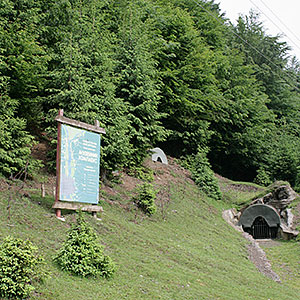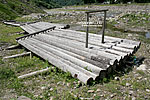Kolochavsky Bokorash
The museum gives a unique opportunity to learn about the process of rafting timber down the rivers of Verkhovyna, and find out a lot of interesting things about the legendary profession of 'bokorash'.
Visitors will get into a real lumberjack's home and see there authentic logging equipment. There's also an exposition of equipment for mountain timber rafting, where you can also take a photo on a big bokor (log raft) and watch an exclusive documentary about the dangerous job of bokorash workers.
Some history of the matter:
Untill the middle of the 20th century, timber from around the Carpathians was transported by mountain rivers, which are typically pretty deep and rapid. The Tereblia river, which flows along Kolochava, is located hight above the sea level and was a convenient transportation route for local bokorash workers. Huge wood logs were bound together in so called bokoras (rafts) and were transported down the river flow. Those rafts were operated by bokorash workers, traditionally extremely brave and physically strong Verkhovynians. This job required extraodinary skillfulness and quick mind, as the process was going on in pretty dangerous and uncertain environment.
In 1951 the new damb for Tereblia-Ritska hydroelectric station started being built on the river. When a water reservoir was made, it solved the electricity problem in the region, but, at the same time, left local bokorash workers without job, as it became impossible to raft timber down the river – a newly created artificial body of water with a high damb blocked the main stream. It was time for the hard and dangerous profession to become a part of history.
Nowadays the exposition is being reconstructed.
Khust district
Kolochava village
Druzhba St., 26
Tel.: +38 (067) 238-09-85
+38 (067) 215-09-85
+38 (03146) 2-41-81
Go by any train of Uzhgorod direction to Volovets station, then take a bus to the centre of Kolochava.
Go by bus Lviv–Khust, Lviv–Tiachiv or Kyiv–Khust to Mizhgirya town, then take a bus to Kolochava. The museum is a part of 'Stare Selo' complex, 1 km far from the village centre (Bradolets quarter direction). There are museum road signs in the village.
More information about public transport.
By car
Go along the road Kyiv–Lviv–Chop (M-06) and in Nyzhni Vorota village turn in Volovets direction and go to Mizhgirya, where you go along the main road and follow signs of Kolochava. Go untill you see Bradolets road sign, follow the direction and go straight on 1 km further to the museum. The museum is a part of 'Stare Selo' complex.

 Ukraine
Ukraine Poland
Poland Slovakia
Slovakia
 Українською
Українською









